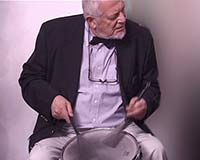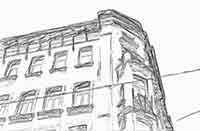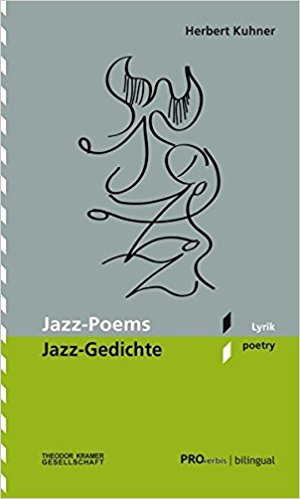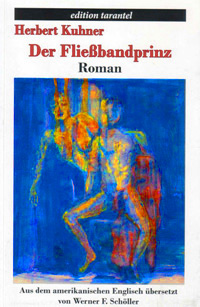Politicians Have Their Say
“You’ll find people in Gurk, who are either Socialists or Conservatives,
who in certain situations may say that Hitler should be here now,
but that doesn’t mean that they are Nazis. [1]
– Karl Felsberger Deputy-Mayor of Gurk, Carinthia
„Austrians may have rejoiced in 1938,
but they welcomed annexation to the Reich,
not National Socialism.“
– Josef Ratzenböck, Conservative Governor of Upper Austria
The Ladies Have Their Say
My poem about the Führer: the product of an innocently glowing heart.
– Gertrud Fusennegger, Austrian author, May 13, 1993
The one thing about the Nazis that I liked
is that they had the best laws for the protection of animals.
– Edith Klinger, Austrian columnist on animal affairs
“There was a dangerous, demented politician who led the German nation on the path to ruin,
we’re all aware of that, but there were also positive values such as children,
mothers and families and sticking together, and those things were done away with..
.there were also Autobahns built, and we drive on them.”
– Eva Herman, German “talkmistress“ in September 2007
“I liked and admired Germany. I could not judge the government since I was completely apolitical.
When I received my first invitation to a reception by Hitler, my only thought was what should I wear?”
– Marika Rökk: A Heart with Paprika; Kurier, December 12, 2010.
Marika was dancer in films of the Thirties who made up for a lack grace with boundless energy.
“I can’t judge how it was with Hitler in all other areas.
I can only judge that he was interested in my doing in test flights.
I was deeply astonished about his questions and his interest.”
– Hanna Reitsch, pilot, interview in English, 1976
(Hanna’s English translated into English:
“I don’t know about other aspects;
I only know that Hitler endorsed my test flights.
His questions and interest a surprised me.”)
“There was a dangerous, demented politician
who led the German nation on the path to ruin,
we’re all aware of that, but there were also positive values
such as children, mothers and families and sticking together,
and those things were done away with…
there were also Autobahns built, and we drive on them.”
– Eva Herman, German-TV “talk-mistress“in September 2007
Yes, the Nazis promoted motherhood and Arian mothers were coddled.
(Non-Arian mothers experienced different treatment.)
Sons were needed for the military and daughters were needed to bear more military men
as well as daughters who were to become the mothers of the military men of the future.
So it went, dear Eva and so it goes.
Now we have women whose aim is a career like yours,
rather than mere parturition.
Ah, those good old days when men were men and women were women
and the only problems woman had were the problems of the maternity ward and the nursery!
Things Weren’t All Bad in Days Gone By
The one thing about the Nazis that I liked
is that they had the best laws for the protection of animals.
– Edith Klinger, Austrian columnist on animal affairs
Don’t quibble! Things may have been bad in days gone by,
but they weren’t all bad. Look, the Nazis were nice to animals!
That’s a good thing, isn’t it?
And there are others aspects. If the Führer hadn’t annexed Austria,
half of the country would probably still be driving on the left-hand side of the road.
Konrad Lorenz and the Geese
Third-Reich theoretician Konrad Lorenz
had grey geese follow him wherever he went.
He was especially enthralled by the goose step.
Wolfgang Schüssel:
Victim not Perpetrator!
Question: Does Austria consider itself as a perpetrator or victim 60 years after the war?
Wolfgang Schüssel: I believe that this question has been decided.
The country (Austria) was a victim of aggression, specifically a military aggression.
That was proven in the night after the occupation when thousands were arrested.
If the Nazi leadership thought that all of Austria was cheering, these arrests
would not have been carried out. The entire political elite was de facto cancelled out.
There was resistance in all political groups. The allies recognized this…
I will never permit Austria not be viewed as a victim.
Definitions
Adolf Hitler had Ernst Röhm and his SA-henchman done away with in June of ‘34.
Röhm was Hitler’s adversary, but he was anything but an anti-Nazi.
Which goes to show that birds of a feather don’t always flock together.
That same year, Hitler ordered the murder of Austrian Chancellor Engelbert Dollfuss.
Dollfuss was an anti-Nazi, but not an anti-fascist.
Stalin was an anti-fascist, but he was not anti-totalitarian.
It is essential to know what one favors as well as what one opposes.
When Josef Goebbels publicized the Soviet massacre of Polish officers in Katyn in 1941,
he did so because it fit into his concept. We know that he was not opposed to massacres,
for the murders he approved of were million-fold.
Gerd Bacher: “The Waldheim-story is a Dreyfus Affair with inverted implications.” [2] “There is no freedom without personal discipline. A dictatorship provides convenient, but short-termed protection against base instincts. You can choose.“[3]
Hans Dichand; “We who experienced war and captivity in Soviet prisoner of war camps do want revenge. But we vigorously oppose the satanic, collective slander that the soldiers of the Second World War were criminals. We don’t want to take the truth to our graves with us. Our descendants, our daughters and sons should be able to stand up for us if we are continued to be condemned as inhuman. Winners are bad judges and the history is also the history the history of falsehoods.[4]
“Seamen who had befriended him (Hans Dichand) offered him an Italian uniform. (for his German one). He refused. It was inconceivable for him to flee into peacetime disguised as an Italian.”[5]
(That uniform represented a war of conquest, a scorched earth policy and countless abattoirs and charnel houses.)
Dichand: “You’d think that after such a long time, bygones should be bygones internationally.[6]
Otto Mauer, Caretaker of Artists’ Souls
In the Nineteen-Fifties Monsignor Otto Mauer, was instrumental in introducing modern art to post-war Austria. He founded the “Galerie St. Stephan” in Vienna and promoted such avant-garde artists as Wolfgang Hollegha, Josef Mikl und Markus Prachensky.
However, artists came on the scene, whose work transcended theirs in sensationalism. Rather than using such materials as canvass, wood and stone, they used the human body, its fluids and secretions. These pioneers worked individually and as a group under the name of the Vienna Actionists, and Mauer concentrated his efforts on promoting them. With his backing, they set about conquering the International Art World, and indeed the trend has spread like wildfire.
Luminaries of the movement are Otto Mühl, Hermann Nitsch, Günter Brus, Peter Weibel, Valie Export and Rudolf Schwarzkogler.
The motto épater le bourgeois was replaced by emmerder le monde. Public sado-masochism and brutality were the means.
Here is background material:
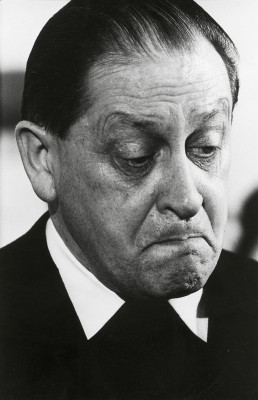
Monsignore Otto Mauer, Gründer der Galerie nächst St. Stephan. Photographie, 1965.
After the war, Otto Mauer along with Bishop Alois Hudal, who was located at the Vatican, was a member of the Vatican Ratline and aided escaping Nazis, as well as those who remained in Austria. Among Mauer’s protégés was former Third Reich publicist Otto Schulmeister, who in turn supported Mauer. Mauer and Schulmeister collaborated as editors on the Catholic cultural monthly Wort und Wahrheit together, which they founded in the Fifties.
Otto Schulmeister, 1989: “There were many swine at the time, not only brown ones…” And he added, “The Revisionists are right about that. Not only Nazis committed crimes. And not only Jews were victims. There were many victims at the time and many since then. And as we see in Israel, Jews can also be oppressors.” Asked whether he regretted what he had written during the Third Reich in National Socialist organs, he replied: “Not in the least!”
Half-Truths are the most dangerous lies.
– Joseph Goebbels
Otto Mauer, pater familias of the actionists, was the official Catholic “caretaker of souls” for artists.
Otto Mauer in 1948, the years after the Holocaust: “The Jews have immense influence on communism and capitalism. They pass themselves off as defenders of humanity…but they are nothing but a depraved people with a perverted spirit….They have been condemned to eternal damnation….They invariably choose the evil path.”
Bishop Egon Kapellari, Austria’s Bishop for Art: “Monsignor Otto Mauer, the unforgotten sponsor of contemporary art of his time, wrote in his renowned text, “A Discourse on Art,” that he was aware that society, yes even the state, had to defend itself against anti-humanistic, racial discriminatory, anti-Semitic, etc. art. “
A year later Mauer was more “conciliatory.” In 1949 he wrote: “There is a solution to the Jewish problem, but just one: the Jews must recognize Christ as the Messiah, the heathens must become Christians…”
Good Deeds
 Mauer’s Austrian colleague Bishop Alois Hudal describes his good deeds: “After 1945 all my charitable work was primarily devoted to the former members of National Socialism and Fascism, particularly the so-called ‘war criminals,’ who were being persecuted and were frequently personally completely without guilt.” [7]
Mauer’s Austrian colleague Bishop Alois Hudal describes his good deeds: “After 1945 all my charitable work was primarily devoted to the former members of National Socialism and Fascism, particularly the so-called ‘war criminals,’ who were being persecuted and were frequently personally completely without guilt.” [7]
Bishop Hudal, Christmas, 1945:“I am delighted to greet 110 wanted war criminals. They can be hunted far and wide. Here they are safe.”[8]
“The Bishop (Hudal) entered the room and welcomed me with outstretched arms and said, ‘You must be Franz Stangl. I’ve been waiting for you.’”[9]
(Franz Stangel was Commandant of Treblinka Concentration Camp. The number of His victims is nine-hundred-thousand.)
Thanks to Hudal and other Cossack-clad friends, Stangl was able to travel to Brasil, where he found employment at the Volkswagon factory in the Sixties and as advisor to the military dictatorship. He was able to combine both jobs by aiding with in interrogations on the factory premises.
Luther writes that the Jews are a serpent’s brood
and one should burn down their synagogues and destroy them.”
One and the Same
Dan was an American Nazi way back in the Lincoln Rockwell days. He was a true fan of the Führer,
and he was convinced that the quondam leader Germany had hit the jackpot with the racial laws.
A party comrade painted a portrait of him in uniform in Adolf-pose with smokestacks in the background.
Dan did not engage in Holocaust denial. He carried a bar of soap around with him with the caption on the wrapper:
“Made from the finest Jewish fat.” Yeah, Dan didn’t like Jews very much. In order to prove his conviction,
he vandalized the offices of the Anti-Defamation League in New York.
But yet Dan wanted to show that not everything Jewish was bad. He’d bring knish to Nazi headquarters
and offer it to his comrades, saying, “Let’s eat this good Jew food!” Say what you will about Jews,
there’s no denying that Jewish food is tasty.
Regretfully for Dan, there was one fly in the ointment. Dan had the bad luck of not being a bonified Aryan.
He hadn’t selected the right parents before birth. His mother and father were pious Jews in the Bronx,
and one set of grandparents had taken the boat to New York from Russia. Yes, fate had played the dirtiest trick on him.
Be that as it may, Dan attempted to rectify this error by choosing to be a Nazi. And he proved himself again and again.
Since Dan had become one of the most ardent members of the American Nazi Party, the media took an interest in him.
Journalists wanted to know the whys and wherefores of his convictions. Even the prestigious New York Times contacted him for an interview.
Dan was flattered and he assented.
The Times interviewer did a little background research and confronted Dan with his true identity. Dan was aghast.
His brown world collapsed. He had besmirched his calling with his identity. The only honorable recourse he had as a Nazi was to kill the Jew
who had dishonored him – these two being one and the same. The Nazi took his pistol and aimed it at the Jew and shot himself dead.
* * * * * *
[1] Profil, No. 23, June, 6, 2005
[2] Neue Kronen-Zeitung, 21. Dez.1986; Gerd Bacher in: “Zeit zum Reden”. Eine noch ältere:
[3] Salzburger Nachrichten, 17. Nov.1949; Gerd Bacher: “Freibeuter der Moral”.
[4] Kronen-Zeitung, Hans Dichand, 23. April 1995.
[5] Kronen-Zeiting, Hans Janetschek, Italiens Flucht aus dem Krieg, p. 28; Hans Janetschek, Nur Ein Journalist, Orac Verlag, 1993.
[6]Kronen-Zeitung, Cato (Hans Dichand), April 17, 2007, p. 3
[7] Alois C. Hudal, Römische Tagebücher, Lebensbeichte eines alten Bischofs, Leopold Stocker Verlag, Graz, 1976, p. 21
[8] Bishop Alois Hudal’s secretary Hans Mayer, tape recording, 1979, Die Waffen SS, ZDF, 2002.
[9] Gerald Steinacker: Nazis auf der Flucht, Studien Verlag, Innsbruck, 2008.
[10] G. M. Gilbert Nuremberg Diary, Straus & Cudhay, 1947, Signet Edition, 1961, p. 384.
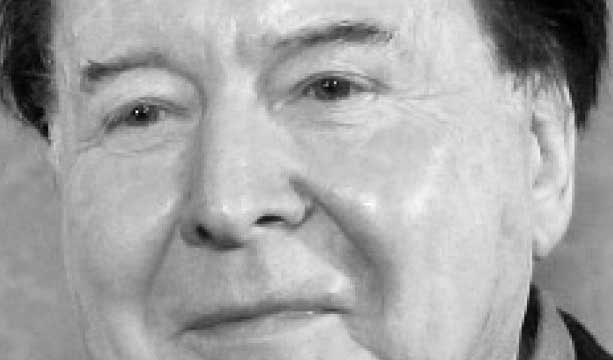 Gerhard Rühm. 4.10.2017 – 28.1.2018. Das Kunstforum Wien zeigt mit Gerhard Rühm im Herbst 2017 einen der letzten Universalkünstler. Als Komponist, Pianist, Performer, Literat und bildender Künstler war der 1930 in Wien geborene und heute in Köln lebende Gerhard Rühm ein Grenzgänger zwischen den einzelnen …
Gerhard Rühm. 4.10.2017 – 28.1.2018. Das Kunstforum Wien zeigt mit Gerhard Rühm im Herbst 2017 einen der letzten Universalkünstler. Als Komponist, Pianist, Performer, Literat und bildender Künstler war der 1930 in Wien geborene und heute in Köln lebende Gerhard Rühm ein Grenzgänger zwischen den einzelnen …










 Users Today : 47
Users Today : 47 Users Yesterday : 153
Users Yesterday : 153 This Month : 367
This Month : 367 This Year : 367
This Year : 367 Total Users : 182172
Total Users : 182172 Views Today : 57
Views Today : 57 Total views : 1877584
Total views : 1877584 Who's Online : 2
Who's Online : 2
 Mauer’s Austrian colleague Bishop Alois Hudal describes his good deeds: “After 1945 all my charitable work was primarily devoted to the former members of National Socialism and Fascism, particularly the so-called ‘war criminals,’ who were being persecuted and were frequently personally completely without guilt.” [7]
Mauer’s Austrian colleague Bishop Alois Hudal describes his good deeds: “After 1945 all my charitable work was primarily devoted to the former members of National Socialism and Fascism, particularly the so-called ‘war criminals,’ who were being persecuted and were frequently personally completely without guilt.” [7] “What will happen even if we do burn down the Jews‘ synagogues and forbid them publicly to praise God, to pray, to teach, to utter God’s name? They will still keep doing it in secret. If we know that they are doing this in secret, it is the same as if they were doing it publicly. For our knowledge of their secret doings and our toleration of them implies that they are not secret after all and thus our conscience is encumbered with it before God.
“What will happen even if we do burn down the Jews‘ synagogues and forbid them publicly to praise God, to pray, to teach, to utter God’s name? They will still keep doing it in secret. If we know that they are doing this in secret, it is the same as if they were doing it publicly. For our knowledge of their secret doings and our toleration of them implies that they are not secret after all and thus our conscience is encumbered with it before God.
